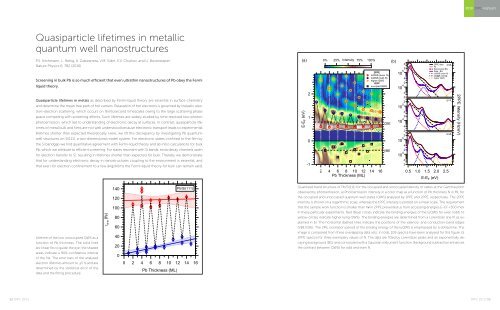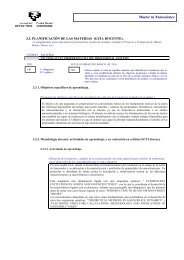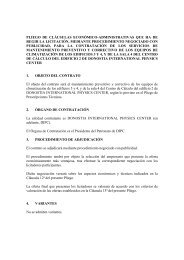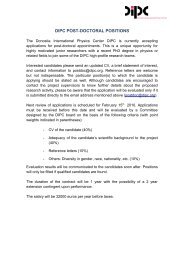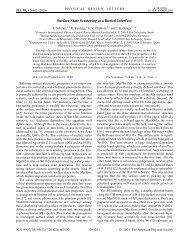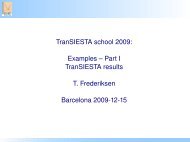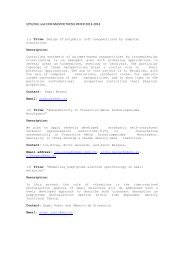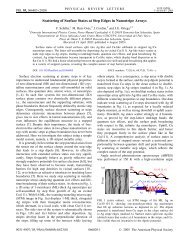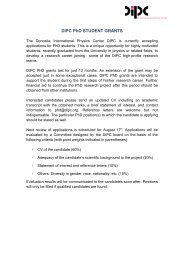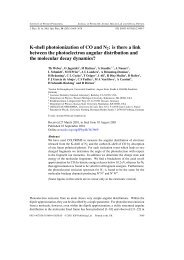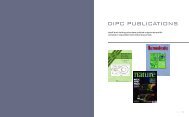Complete report - Donostia International Physics Center - Euskal ...
Complete report - Donostia International Physics Center - Euskal ...
Complete report - Donostia International Physics Center - Euskal ...
You also want an ePaper? Increase the reach of your titles
YUMPU automatically turns print PDFs into web optimized ePapers that Google loves.
t e-e (fs)<br />
E-E F (eV)<br />
2PPE<br />
(even N)<br />
luQWS<br />
(odd N)<br />
luQWS<br />
QWS<br />
higher<br />
1PPE<br />
QWS<br />
occupied<br />
data<br />
2PPE<br />
Fit<br />
BG<br />
Exponential<br />
- BG Data<br />
(even N)<br />
luQWS<br />
(odd N)<br />
luQWS<br />
2PPE Intensity (Hz/eV)<br />
2010 DIPC Highlight<br />
Quasiparticle lifetimes in metallic<br />
quantum well nanostructures<br />
P.S. Kirchmann, L. Rettig, X. Zubizarreta, V.M. Silkin, E.V. Chulkov, and U. Bovensiepen<br />
Nature <strong>Physics</strong> 6, 782 (2010)<br />
(a) 0% 25% 75% 100%<br />
Intensity<br />
(b)<br />
4<br />
4ML<br />
10 5 2<br />
Screening in bulk Pb is so much efficient that even ultrathin nanostructures of Pb obey the Fermi<br />
liquid theory.<br />
4<br />
higher QWS<br />
10 4 2<br />
4<br />
Quasiparticle lifetimes in metals as described by Fermi-liquid theory are essential in surface chemistry<br />
and determine the mean free path of hot carriers. Relaxation of hot electrons is governed by inelastic electron–electron<br />
scattering, which occurs on femtosecond timescales owing to the large scattering phase<br />
space competing with screening effects. Such lifetimes are widely studied by time-resolved two-photon<br />
photoemission, which led to understanding of electronic decay at surfaces. In contrast, quasiparticle lifetimes<br />
of metal bulk and films are not well understood because electronic transport leads to experimental<br />
lifetimes shorter than expected theoretically. Here, we lift this discrepancy by investigating Pb quantumwell<br />
structures on Si(111), a two-dimensional model system. For electronic states confined to the film by<br />
the Si bandgap we find quantitative agreement with Fermi-liquid theory and ab initio calculations for bulk<br />
Pb, which we attribute to efficient screening. For states resonant with Si bands, extra decay channels open<br />
for electron transfer to Si, resulting in lifetimes shorter than expected for bulk. Thereby we demonstrate<br />
that for understanding electronic decay in nanostructures coupling to the environment is essential, and<br />
that even for electron confinement to a few ångströms the Fermi-liquid theory for bulk can remain valid.<br />
2<br />
1<br />
0<br />
-1<br />
CBE<br />
VBE<br />
2<br />
2<br />
5 10<br />
4<br />
2<br />
4 10<br />
4<br />
2<br />
2<br />
5 10<br />
4<br />
2<br />
4 10<br />
4<br />
2<br />
5ML<br />
6ML<br />
1.0<br />
4<br />
16<br />
0.5<br />
14<br />
2<br />
12<br />
2.5<br />
2.0<br />
1.5<br />
6<br />
8<br />
10<br />
Pb Thickness (ML)<br />
E-E F (eV)<br />
Lifetime of the low unoccupied QWS as a<br />
function of Pb thickness. The solid lines<br />
are linear fits to guide the eye; the shaded<br />
areas indicate a 90% confidence interval<br />
of the fits. The error bars of the analysed<br />
electron lifetimes amount to ±5 fs and are<br />
determined by the statistical error of the<br />
data and the fitting procedure.<br />
140<br />
120<br />
100<br />
80<br />
60<br />
40<br />
20<br />
0<br />
0<br />
2<br />
4<br />
6<br />
8<br />
10<br />
Pb Thickness (ML)<br />
Pb/Si(111)<br />
12 14 16<br />
Quantized band structure of Pb/Si(111) for the occupied and unoccupied density of states at the Gamma point<br />
observed by photoemission. a) Photoemission intensity in a color map as a function of Pb thickness N in ML for<br />
the occupied and unoccupied quantum-well states (QWS) analysed by 1PPE and 2PPE, respectively. The 2PPE<br />
intensity is shown on a logarithmic scale, whereas the 1PPE intensity is plotted on a linear scale. The requirement<br />
that the sample work function is smaller than hν in 2PPE prevented us from accessing energies E−EF


